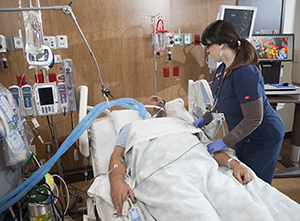Inside the ICU (Intensive Care Unit)

The ICU is a busy place. There may be other people with monitors in the same unit. Be prepared to see lots of wires, tubes, and equipment. Sounds will range from the machines working to buzzers and alarms. Smells can range from antiseptic cleaners to various odors from specific medical problems and treatments.
Your loved one
Your loved one may be asleep, very drowsy, or unconscious. Surgery or illness may cause the skin to appear pale, flushed, or a gray color (ashen). The person may look puffy and swollen, especially the face, hands, and feet. They may feel cold and clammy. This is the body’s normal reaction to stress, low blood pressure, certain medicines, and some diseases.
Monitors
Monitors have alarms that signal the medical team when something needs to be checked. These are not always cause for concern. Sometimes even a patient’s movement may sound an alarm. But if you see something that doesn't seem right, let the medical team know.
Oxygen
Patients in the ICU often need extra oxygen. It may be given through a face mask, ventilator, or nasal cannula. The nasal cannula is a long, soft tube with two prongs at the end. They fit just inside the nose.
Ventilator
A ventilator is a machine that helps a person breathe. It does this by pushing air into the lungs. If your loved one has breathing problems or needs sedation, they may be connected to a ventilator by a special tube. The tube goes in through the nose or mouth. If the person needs to be on the ventilator for an extended period of time, the medical team will make a cut (incision) called a tracheostomy in the throat. A shorter tube will be placed in the hole. This may be connected to the ventilator. The patient will be unable to speak while on a ventilator. Flash cards or a writing tablet may help in communication.
Compression stockings
Special compression stockings or other devices may be used to help prevent blood clots in the legs.
Tests
Frequent tests and treatments may be done. At times like these, you may be asked to leave the room to clear the area around the patient. Blood may be drawn often. The body contains a large volume of blood and slowly replaces any blood drawn. X-rays may be done in the hospital room. Or they may be taken to another department for additional imaging tests.
Medicine
Medicines can cause sleepiness, nausea, or confusion. Your loved one may be getting several types of medicine. These can include antibiotics, sedatives, and medicine for pain. Let the nurse know if your loved one seems to be in pain.
IV lines and tubes
Your loved one may have one or more IV (intravenous) lines and tubes in place. Tubes help drain or suction fluids or air from the patient’s body. Some IV lines provide fluids, nutrition, and medicine. Others measure blood or heart pressure. All lines and tubes are closely monitored. They are changed often to prevent infection.
Restraints
Your loved one’s hands and sometimes ankles may need to be restrained for their safety. This is especially true if they are confused. This prevents them from pulling out tubes or wires.